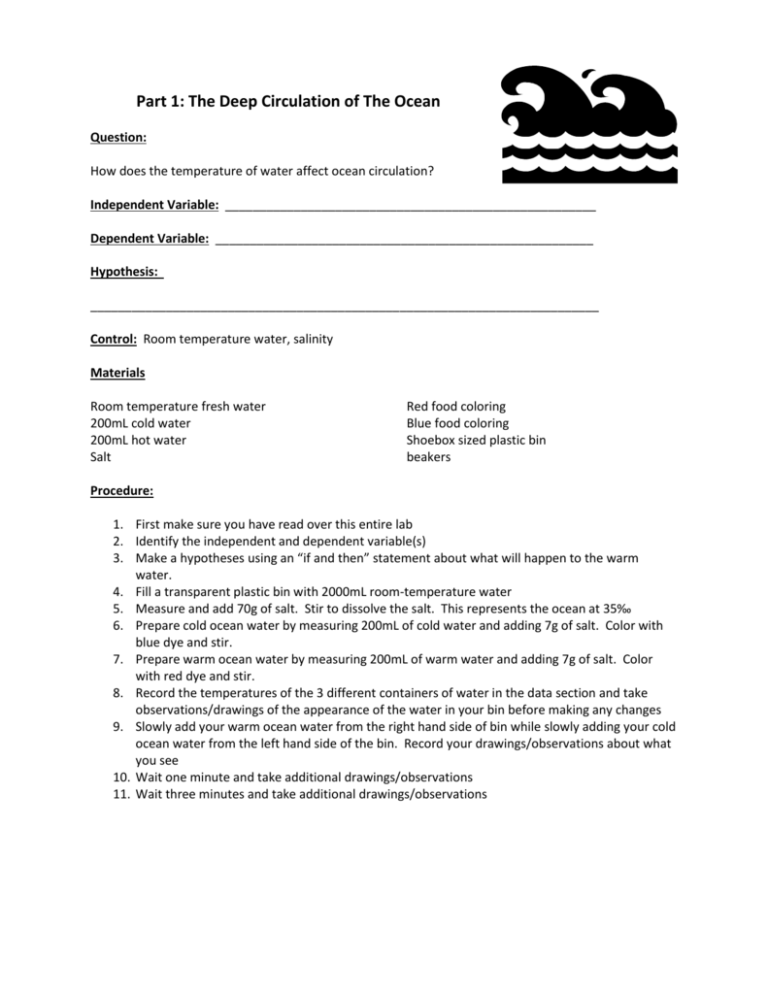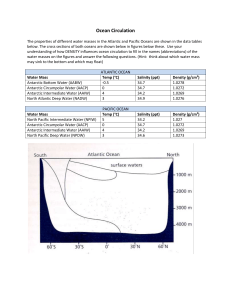DEEP OCEAN WATER LAB 2013
advertisement

Part 1: The Deep Circulation of The Ocean Question: How does the temperature of water affect ocean circulation? Independent Variable: ______________________________________________________ Dependent Variable: _______________________________________________________ Hypothesis: __________________________________________________________________________ Control: Room temperature water, salinity Materials Room temperature fresh water 200mL cold water 200mL hot water Salt Red food coloring Blue food coloring Shoebox sized plastic bin beakers Procedure: 1. First make sure you have read over this entire lab 2. Identify the independent and dependent variable(s) 3. Make a hypotheses using an “if and then” statement about what will happen to the warm water. 4. Fill a transparent plastic bin with 2000mL room-temperature water 5. Measure and add 70g of salt. Stir to dissolve the salt. This represents the ocean at 35‰ 6. Prepare cold ocean water by measuring 200mL of cold water and adding 7g of salt. Color with blue dye and stir. 7. Prepare warm ocean water by measuring 200mL of warm water and adding 7g of salt. Color with red dye and stir. 8. Record the temperatures of the 3 different containers of water in the data section and take observations/drawings of the appearance of the water in your bin before making any changes 9. Slowly add your warm ocean water from the right hand side of bin while slowly adding your cold ocean water from the left hand side of the bin. Record your drawings/observations about what you see 10. Wait one minute and take additional drawings/observations 11. Wait three minutes and take additional drawings/observations Data: Water Room Temperature Seawater Hot Seawater Cold Seawater Drawings/Observations Before During 1 min later 3 min later Temperature (⁰C) Questions: 1. How did your results compare to your predictions? Explain any differences. 2. Why did we choose to keep the salinity the same (35‰) with each different sample of water? (Hint: think about what we are trying to test) 3. What is one way you might improve the procedure for this experiment in order to get more accurate results? 4. How is this investigation related to deep ocean currents in our oceans? (hint: think temperature, density, and salinity) Part 2: The Deep Circulation of The Ocean The properties of different water masses in the Atlantic and Pacific Oceans are shown in the data tables below. The cross sections of both oceans are shown below in figures below these. Use your understanding of how DENSITY influences ocean circulation to fill in the names (abbreviations) of the water masses on the figures and answer the following questions. (Hint: think about which water mass may sink to the bottom and which may float) Water Mass Antarctic Bottom Water (AABW) Antarctic Circumpolar Water (AACP) Antarctic Intermediate Water (AAIW) North Atlantic Deep Water (NADW) Water Mass North Pacific Intermediate Water (NPIW) Antarctic Circumpolar Water (AACP) Antarctic Intermediate Water (AAIW) North Pacific Deep Water (NPDW) ATLANTIC OCEAN Temp (°C) -0.5 0 4 3 Salinity (ppt) 34.7 34.7 34.2 34.9 Density (g/cm3) 1.0278 1.0272 1.0269 1.0276 PACIFIC OCEAN Temp (°C) 5 0 4 3 Salinity (ppt) 34.2 34.7 34.2 34.6 Density (g/cm3) 1.027 1.0272 1.0269 1.0273 1. Temperature and salinity are the two primary factors controlling the density of a water mass. Propose two ways that temperature and salinity could change, thereby changing the density and location of the water mass. 2. If a water mass became less dense, how might that affect ocean circulation patterns? 3. Does wind affect deep ocean circulation? Explain. 4. Watch the video at http://www.youtube.com/watch?v=3niR_-Kv4SM. Describe what is happening. What do you think is the primary reason for the water movement in this animation? 5. Read the article at http://www.windows2universe.org/earth/Water/circulation1.html as well as your textbook to answer the following question: Another word for deep ocean circulation is “thermohaline circulation” or the “the great ocean conveyor”. Why would ocean circulation be described as a conveyor belt? What is being moved on this conveyor belt? 6. Some scientists believe that changes in the density of water masses may cause abrupt and sudden climate change. Why do they believe this? Summarize their argument. 7. Use the following resources at: http://www.classzone.com/books/earth_science/terc/content/visualizations/es2405/es2405pa ge01.cfm?chapter_no=visualization and http://ww2010.atmos.uiuc.edu/%28Gh%29/guides/mtr/eln/upw.rxml as well as your textbook to help you answer the following question: What is upwelling?








